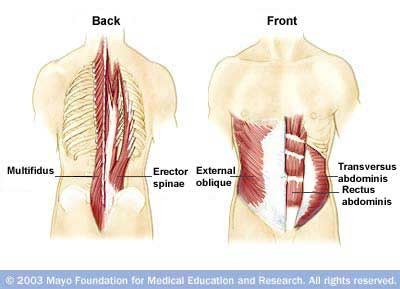
There are a few healthcare professions that you can go to when you have back pain. A licensed physical therapist has the knowledge and training to treat the back and spine with a number of techniques including, but not limited to, manipulation and other manual therapy techniques, strengthening, and educating the patient as to what is causing their pain and what will help eliminate this pain. Studies have shown that these three treatments
have been found to be the most effective treatments for back pain1.
It is important to go to a physical therapist for back pain as research has shown that the important muscles that protect the spine and aid in its stability stop working properly. Research has also shown that after back pain resolves, one of the most important muscles that stabilizes the spine, called the multifidus, does not spontaneously recover2.
The multifidus is a small, powerful muscle in the back that attaches along the spine which aides in rotation and back extension. However, its most important role is to stabilize the spine during every day movements. In healthy individuals with properly functioning multifidus, it is contracted each time your spine moves to keep it in proper alignment and prevent injury or damage to the spinal cord and spinal nerves. The multifidus muscle is so important that it provides 66% of the stiffness at the most commonly injured spinal level in the low back2.
Research has also proven that the other most important muscle in your body that stabilizes your spine, the transverse abdominis (TA) muscle, does not contract effectively in patients’ with low back pain3. The TA is the deepest abdominal muscle in our body. It acts as a corset as it wraps around your abdomen and attaches at the spine. It contracts before any limb or the other abdominals to stabilize the spine for movement4.
So, how do you know if your TA and multifidus are weak and how do you retrain them? Check out my articles next week to find out!
Mike Cunningham, DPT
References:
1. Paris SV. Physical Signs of Instability. Spine. 1985; 10(3): 277 — 279.
2. Hides JA, et al. Multifidus Muscle Recovery Is Not Automatic After Resolution of Acute, First Episode Low Back Pain,Spine. 1996; 21(23): 2763 – 2769.
3. Hodges PW, Richardson CA. Inefficient muscular stabilization of the lumbar spine associated with low back pain: a motor control evaluation of transverse abdominis. Spine. 1996; 21(22):2640-2650.
4. Hodges PW, Richardson CA. Contraction of the abdominal muscles associated with movement of the lower limb. Physical Therapy. 1997; 77(2):132-142.

